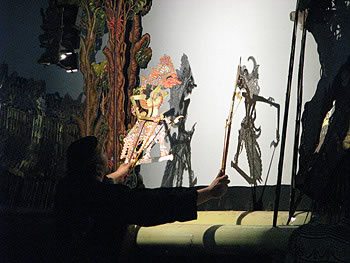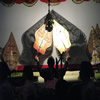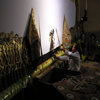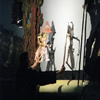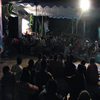The Dhalang (Puppeteer)
As the central artist of wayang kulit, the dhalang really makes the wayang and the performance come alive. He (commonly, but not exclusively male) manipulates every character, conducts the gamelan orchestra, and sometimes makes puppets or designs them. These skills are usually passed from generation to generation, and today many dhalang enhance their training by attending a formal art institute with degree programs in dhalang studies.
Each dhalang brings his own style, humor, and innovation to the performance, providing for a unique experience at every show. Traditional wayang kulit performances last all night, averaging nine hours, without an intermission or break. The dhalang remains seated, in a cross-legged position, facing the screen in front of him and his voice remains strong and clear. These abilities demonstrate the stamina and strength of the individual dhalang.
Audiences of wayang kulit are not “tuned in” for the duration of the show. People walk around, socialize, nap, eat, come and go. Spectators depend on cues from the dhalang to pull their attention back to the performance for important scenes.
Truly, the dhalang is a master. He is a puppet master, a shadow master, a literary and linguistics master, and a leader. He is an entertainer who must have a strong voice for songs and poetic narration, and a strong sense of humor for telling effective jokes. The dhalang is also a political analyst and commentator on current affairs. However, his ultimate role is that of teacher. His foremost responsibility is to inform people about wayang kulit — the meaning of the puppets, the philosophy behind the stories, cultural values, and the mysteries of the universe and human nature.
It is for their extraordinary artistic talents and philosophical insights that dhalang are highly respected in their culture and regarded as spiritual people.


